Summary
Efforts in Automotive Crystal Units
Efforts in Automotive Crystal Units
[  PDF]
PDF]
1. Introduction
Crystal units are one of the unique electronic components that control and select frequencies with high accuracy and stability by their high Quality value. It is widely used not only as a "frequency standard" but also as a reference for "time".
Crystal units are used in a wide variety of applications, including clocks, smartphones, TVs, audio equipment, and automobiles.
In recent years, automobiles have become increasingly electrified, and many quartz crystals are used in automobiles.
Automotive crystal units requires higher quality and reliability than ordinary crystal units.
In order to satisfy high quality and high reliability, not only advanced design technologies, but also high level of technical skill and awareness in manufacturing are required, ranging from the construction of production lines for automotive use to workers engaged in operations.
In this section, we introduce Nihon Dempa Kogyo Co., Ltd. (hereinafter NDK)'s efforts in automotive crystal unit, which maintains an industry-market share of 50% or more in automotive crystal units.
2. Efforts in automotive crystal units (1)-Compliance with automotive standards
When we hear about automotive products (qualities) in electronic components, many people think about the quality management system IATF16949 (former ISO/TS16949) and automotive requirements standard AEC-Q200 (passive components: crystal unit is in this category) defined by Automotive Electronics Council (AEC).
NDK's automotive crystal units meets automotive standards mainly from the following three perspectives.
1) Product design
We design products that satisfy the AEC-Q200.
In order to ensure high quality and reliability from the design stage, experts review and confirm the validity of the verification results using DRBFM (Design Review Based on Failure Mode) at the Design Review Committee.
In addition to considering the operating environment (extreme cold and hot) of the automobiles, we also design for even higher temperature environment, such as near engines from -40°C to +150°C.
NDK is considering even if it is outside this temperature range, so please contact us if necessary.
2) Product evaluation
In the quality and reliability evaluation of products , we verify not only the mass production line but also the production facility capacity and the reliability of measurement instruments for design verification at each design and development stage.
Even after the start of mass production, we periodically evaluate and verify the quality and reliability of our products.
As a specialized organization that evaluates and verifies quality and reliability, NDK has established an in-house quality assurance laboratories that have acquired ISO/IEC 17025 (*1) certification, and constantly evaluate and verifies the quality and reliability of its our products objectively.
(*1): ISO/IEC17025 is an international standard that certifies that the laboratory is capable of producing accurate measurement/calibration results.
3) Production plant
NDK has obtained not only IATF16949 certification but also ISO14001 certification at all of its domestic and overseas plants that produce automotive products.

3. Efforts in automotive crystal unit (2)-NDK's unique actual examples
In order to provide high-quality, high-reliability automotive crystal units that cannot be determined by product performance alone, we would like to introduce how NDK is taking this initiative.
1) Production line
The production line for automotive products is a dedicated line separated from general products.
Plates and labels clearly indicate that the line is an automotive line to distinguish it from a general line (Fig. 1).

2) Operator
Automotive product operators conduct automotive education, and those who pass the tests are certified as product operators for automotive use.
This system has been introduced not separately for each production plant, but as a company-wide system for the NDK Group.
Only highly quality-conscious and skilled operators are involved in the production of automotive crystal units.
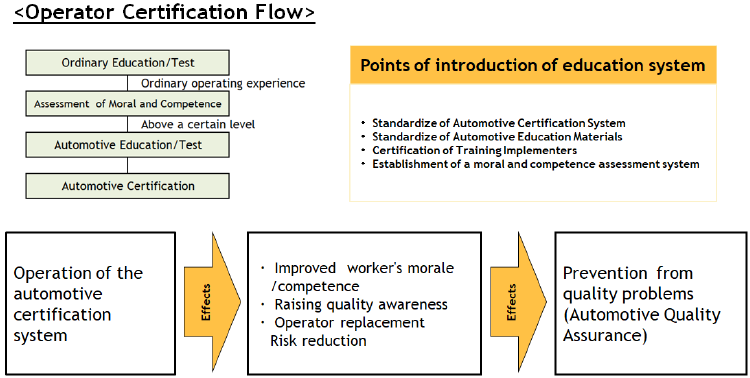
3) Inspection
Inspections of Automotive crystal units, unlike inspections of general products, are conducted not only to satisfy the customer's requirements.
By inspecting the important characteristics of a product based on the actual performance values of the product design ,we manage to maintain high quality and reliability with little variation in product performance and quality.
In this way, NDK's automotive crystal units are designed from the product design stage products for automotive use, even if it has the same appearance as a general used crystal units, and are manufactured the products at mass production plants that complies to the automotive quality management system.
In addition, all of our products, from production facilities and production lines to operators, are manufactured using processes that are exclusively controlled for use in automotive.
After mass production begins, the Quality Assurance Laboratory constantly conducts quality and reliability evaluation of products to maintain and improve high quality. As a leading company in the field of automotive crystal units, we provide products that customers can use with confidence.
The Advantages of Internal Structures
[  PDF ]
PDF ]
Introduction
Crystal units are one of the unique electronic components that controll and select frequencies with high accuracy and stability by their high Quality value. It is widely used not only as a "frequency standard" but also as a reference for "time".
Crystal units are used in a wide variety of applications, including clocks, smartphones, TVs, audios equipment, and other home appliances, as well as automobiles.
In recent years, automobiles have become increasingly electrified, and the need for quartz oscillators for automotive applications has risen.
Therefore, sophisticated design technologies with improved high reliability and robustness is required to meet the needs of such applications.
We explain the advantages of the internal structure of the automotive SMD crystal units , which is proposed by the Nihon Dempa Kogyo Co., Ltd. , which maintains an industry share of more than 50% in the automotive crystal unit market.
1. Crystal unit structures
The crystal unit packages are hollow-structured, and the external and internal terminals are wired and connected to the ceramic base.
The crystal element mounted in crystal unit packages is made of synthetic quartz crystal (IEC)(*1) that is cut, polished, and processed into individual pieces, to form a thin film electrodes on the front and back sides.
To electrically connect and mechanically hold the electrodes formed on the front and back sides of the crystal element the crystal element to is held and connected to the ceramic base at two points using conductive adhesive.
The crystal unit is hermetically sealed with ceramics bases (holding the crystal blank) and ceramic covers. By connecting the external termina of the ceramic base to the oscillation circuit, the crystal unit can obtain its specific frequencies by converting the internally connected crystal blank into electric signals that vibrate at mechanical resonances.
The internal structure of our automotive crystal unit; NX3225GA (3.2mm × 2.5mm).
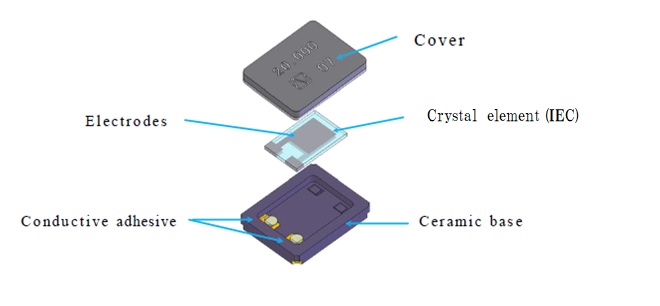
2. Crystal element holding structures
As described above, the crystal element may be held at two points even in the automotive crystal unit.
Even if the crystal element is held at two points, the structure satisfies the reliability required for automotive applications such as AEC-Q200 *2.
However, in automotive applications, the need for improved high reliability and robustness has increased, and the internal structure has been developed to hold a crystal element at four points.
The internal structure of our automotive crystal unit: NX3225GB (3.2mm × 2.5mm).
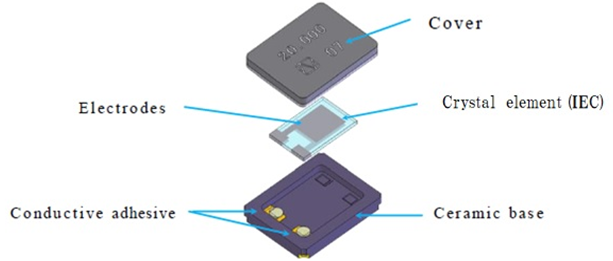
3. Advantages of a crystal element four-point holding structure
NDK utilizes the latest simulation technology to design structures.
We conducted a simulation of the drop impact and the structural resonance point.
(1) Improvement of drop impact resistance
The following shows the results of simulated stresses applied to the crystal element holding parts during a drop impact.
* Simulation Conditions: Stresses applied to adhesive part (crystal element and conductive adhesive) when an impact is applied to a crystal unit.

If the stress applied to the holding part is 1 in the crystal element two-point holding structure, the stress will be 1/5 in the crystal blank four-point holding structure.
This is because the four-point crystal element holding structure disperses stresses.
This four-point crystal element holding structure improves the drop impact resistance performance, and provides a crystal unit that continues to oscillate even after being dropped 200 times onto concrete at a height of 3 meters.
In this way, ND offers a lineup of four-point crystal element holding structure products with improved reliability and robustness by dispersing the stresses applied to the holding of crystal blank to meets the needs of customers.
(2) Avoiding resonance phenomena between ultrasonic welding machines and crystal unit
Usually, when board assembly is performed by ultrasonic welding, the frequency of the ultrasonic welding machine is at about 10 kHz to 40 kHz.
Simulation results of crystal unit (3.2 mm × 2.5 mm) structure resonance-point are shown.
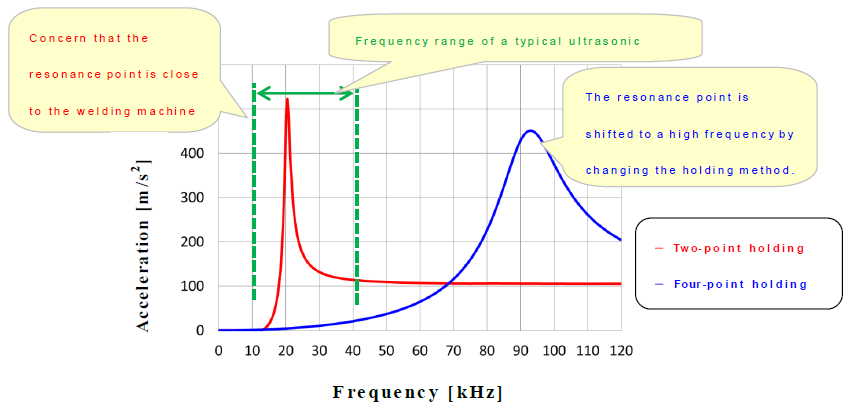
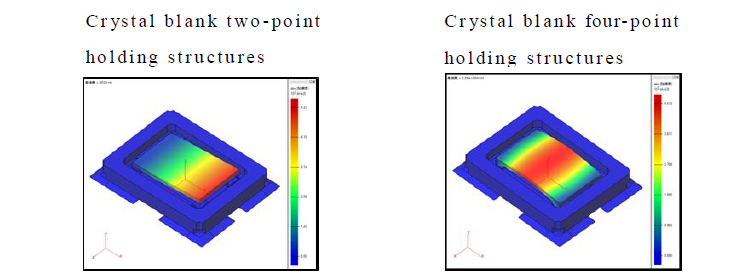
In the crystal element two-point holding structure, It can be seen that there is a structure resonance point at about 20 kHz.
On the other hand, it can be seen that the four-point crystal element holding structure has a structural resonance point at about 90kHz.
When an ultrasonic welding machine is used by customers, the frequency of the ultrasonic welding machine and the frequency of the two-point crystal element holding crystal unit may overlap the resonance point, and the crystal unit may be internally destroyed by the resonance phenomena.
In order to avoid this problem, NDK offers a lineup of four-point crystal element holding structural products designed to meet the needs of customers as below.
Automotive crystal unit 3225 series NX3225GB·NX3225GD·NX3225SA·NX3225SC
2016 series NX2016GC·NX2016SJ (Please contact us)
*1.Synthetic quartz crystal(IEC) is produced by NDK.
*2.AEC stands for "Automotive Electronics Council (Automotive Electronic Components Council)". It is an industry organization for the standardization of reliability and certification standards, consisting of major U.S. car manufacturers and major electronic component manufacturers.
Q200 is an accreditation standard that establishes various reliability tests for passive components. Crystal unit is classified as AEC-Q200.
